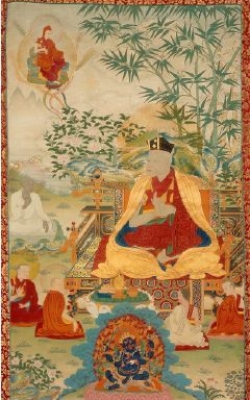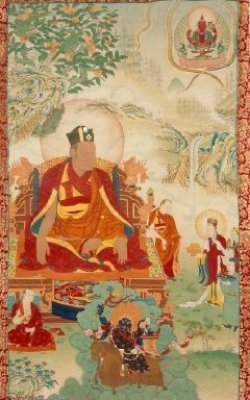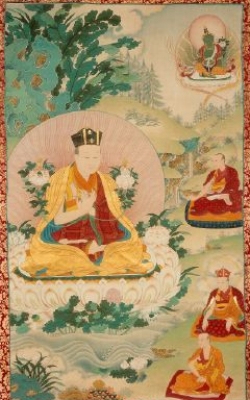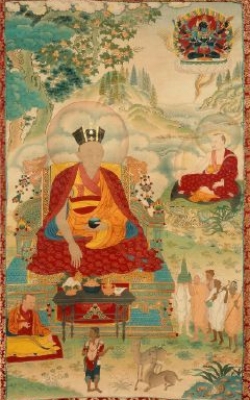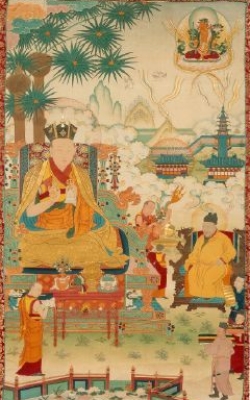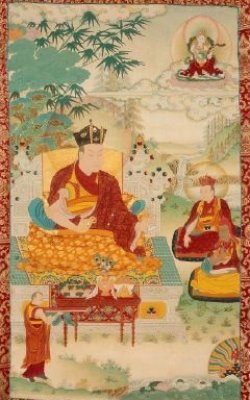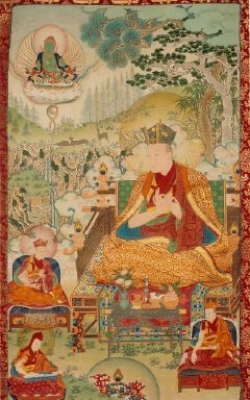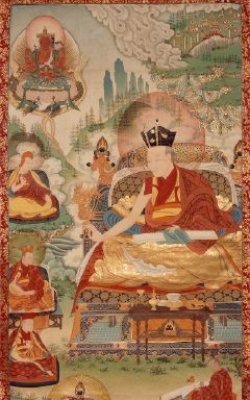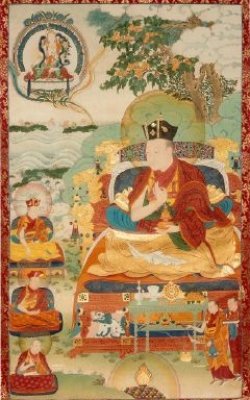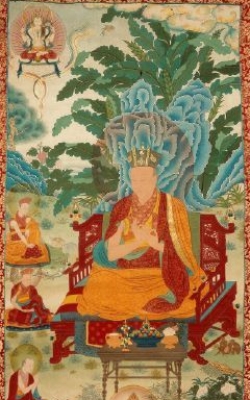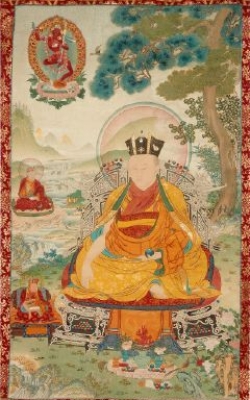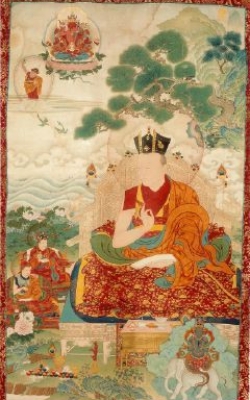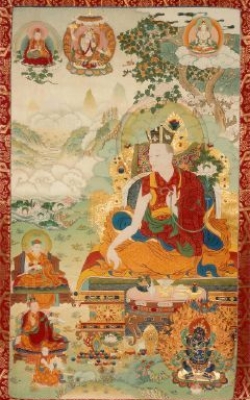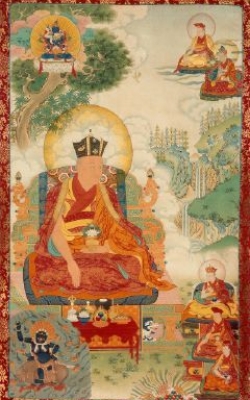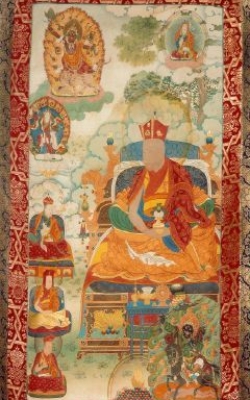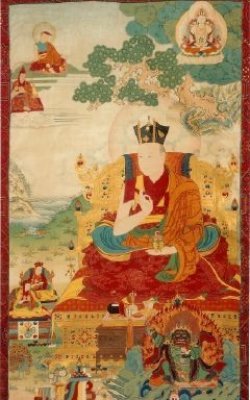Karmapa VIII - Mikyöd Dorje
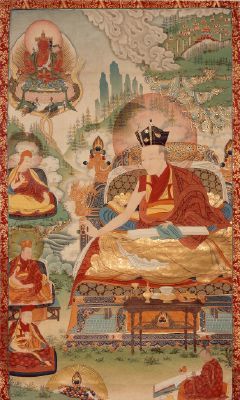
THE VIIIth KARMAPA
(1507 - 1554)
Shortly before his death the seventh Karmapa, Chodrag Gyatsho had a visionary experience of Maitreya, the next Buddha, who said, “We are approaching the end of the age of Buddha Sakyamuni and many people are going to lower realms. So, you must emanate many incarnations of yourself." In addition, Chodrag Gyatsho foresaw the circumstances of his next birth. On waking the next morning, he wrote down the details, which he eventually entrusted to his regent.
On the fourth day of the eleventh month of 1507, the eighth Karmapa, Mikyo Dorje was born in Damchu in eastern Tibet. The newborn child opened his eyes and said, "Karmapa."
News of the remarkable child spread quickly and reached the ears of the third Situ Rinpoche, Tashi Paljor, who realized that the child's place of birth agreed with the details left in Chodrag Gyatsho's prediction letter. Situ Rinpoche decided to investigate the child and interviewed the parents. He was satisfied by the similarity between the actual names of Karmapa’s parents and those names left in the letter of prediction. In addition, all the other details matched. Situ Rinpoche confirmed that the child was indeed the new incarnation of Karmapa, but asked the parents to maintain absolute secrecy for three months in order to protect the child from unwholesome intrigue. He gave the parents some blessing pills, some tea, some butter, and some frankincense and said to them, "Give butter tea to the boy and burn this incense before him, saying that it was sent by Situ Rinpoche. Then give him the blessing pills. If he really is the Karmapa incarnation, he will utter a few words. Tell me what he says."
The father followed these instructions and the infant Karmapa uttered the syllables, E, MA, HO, end declared. "Do not doubt me, I am Karmapa." This was reported to Situ Rinpoche, and at the age of three months the young incarnation accompanied him to Karma monastery. Subsequently the child was visited by the great meditation master, Ser Phowa, who had been a close student of the seventh Karmapa. When an offering puja was performed, the tiny Karmapa played the hand-drum and bell perfectly. Ser Phowa asked him, “If you are Karmapa, do you remember what you taught me in Tse Lhakhang?” The boy replied, “l gave you Mahamudra and the six doctrines of Naropa.”
In 1512. at the age of five, Mikyo Dorje journeyed to Riwoche. There he was asked by Lama Sonam Rinchen to say who he really was. The boy laughed and declared, ''Sometimes I am Padmasambhava, sometimes Saraha and at other times I am Karmapa. I have many emanations. In Tsang province there are sixteen, and west of Tibet there is a chieftain who is my emanation.”
In the same year a young boy from the region of Amdo was put forward as a rival claimant to be the new Karmapa incarnation. Gyaltshab Rinpoche set out to investigate the rival's claims but when he met Mikyo Dorje, he spontaneously felt compelled to bow down to him. Realizing this boy was the Karmapa incarnation, Gyaltshab Rinpoche sent letters of authority to all Karma Kagyu monasteries in which he declared that, according to a prediction by Padmasambhava, the name of the eighth Karmapa was Mikyo Dorje. In the following year, Gyaltshab Rinpoche ceremonially enthroned the young boy as the eighth Karmapa at Tse Lhakhang.
The education of the eighth Karmapa commenced when he reached the age of seven. His first tutor was Situ Rinpoche, from whom he received the eight morel precepts and some elementary Kagyu teachings. Then Mikyo Doric set out on a tour of monasteries. At Surmang monastery a vision of the Kagyu lineage evoked in him. realization of the richness of his inheritance. A little later the young Karmapa met with the meditation master Sangye Nyenpa, whom Chodrag Gyatsho had appointed as the transmitter of the lineage to his next incarnation.
Following this initial meeting, Mikyo Dorje and his camp traveled into far Kham. The unfoldment of his inner potential was continued by a visionary experience in which he received teachings from Sakyamuni Buddha accompanied by his two chief students, Sariputra and Mahamaudgalyayana. While in this area, the young Karmapa incarnation had a very significant dream in which a Dakini told him, "You are the activity aspect of the Buddhas of the three times."
Mikyo Dorje and his party returned briefly to Riwoche, where he carried out both religious and welfare work. Afterward Karmapa revisited the area of his birth in Damchu province. There he had a profound visionary experience in which Guru Padmasambhava revealed to him his true nature, saying, “I am Padmasambhava and you are my principal student, Gyalwa Choyang. The unity of our two natures is Vajradhara.” A short time after this. Mikyo Dorje, inspired by the memory of Dusum Khyenpa, made a pilgrimage to Kampo Gangra. It is said that he left footprints in the various meditation caves there.
In 1516 the nine year old Karmapa received an invitation from the king of Jang Sa-tham. The invitation was accepted, and Mikyo Dorje, accompanied by his camp, set out. The party was welcomed with great ceremony on its arrival and the king lavished honour and offering on the young Karmapa. The uncontrived dignity of Mikyo Dorje made a deep impact on the king, who had previously not been well disposed to Buddhism. He made provision for the support of the dharma in his territories and also undertook to adopt a policy of nonaggression in political matters. Before leaving, Mikyo Dorje promised to return in seven years.
In 1517 the young Karma,a entered into the most important phase of his education. During the next three years he received, from Lama Sangye Nyenpa, a thorough grounding in a comprehensive range of Buddhist teachings, in addition to the complete transmission of the Karma Kagyu lineage. Despite his wealth, Sangye Nyenpa was a perfect example of Kagyu asceticism. At the conclusion of this three-year period of teaching he died, without regret. in the knowledge that Mikyo Dorje had absorbed his instructions. During the funeral ceremonies, Karmapa experienced the presence of his deceased guru and received absolute clarification of his teachings.
Mikyo Dorje was similar to the third Karmapa in his appetite for learning and scholarship. He was a very talented linguist and mastered Sanskrit grammar under the direction of Lotsawa Richen Tashi. The eighth Karmapa also ventured into the fields of poetry, painting and sculpture, where he met with considerable success. As a monk Mikyo Dorje was an example of austerity and simplicity. As a master of Mahamudra he lived in realisation that whatever arises is self-liberated.
In one of his visions, a monk appeared to Mikyo Dorje announcing that he had been Padmasambhava during the age of the previous Buddha, Dipamkara. Mikyo Dorje responded with a question,”If this is so, where was your 'lotus birth' and where did you stay?” The monk replied, “Where did space come from? He then disappeared. Reflecting on this, Karmapa realized that each of the thousand buddhas is accompanied by a Padmasambhava as a natural expression of the teaching of enlightenment.
Subsequently Mikyo Dorje and his great camp travelled slowly through Kham, where he gave teachings to more than ten thousand people. During this tour he recognized the third Gyaltshab tulku, Drakpa Paljor, and the fifth Shamar Rinpoche, Konchog Yenlag. Al Mar Kham, Mikyo Dorje carved a statue of himself out of stone. It is recorded that he placed the statue in front of him and asked it, "Are you a good likeness of me?' The statue replied, “Yes, I am.'' Then Karmapa squeezed a chunk of left-over stone like piece of butter, leaving the imprint of his palm and fingers in it. Both the statue and the stone have been preserved and are now at the residence of the present Karmapa at Rumtek monastery in Sikkim.
On his arrival at Karma monastery, Mikyo Dorje met emissaries of the Chinese Emperor Wu Tsung, who presented him with many invitation offerings and on behalf of the emperor, invited him to China. However, Karmapa foresaw the emperor's imminent death and declined the invitation. The Chinese envoys took offence at this and repacking the emperor's offerings to Karmapa, returned to China, where they discovered that the empress and emperor had just died.
From Kham, Mikyo Dorje travelled to central Tibet. At Samding, the Dorje Phagmo tulku made the offering of a monastery to him. On reaching Tsurphu, he found it was in a state of disrepair and arranged for restoration work to be carried out. Karmapa was visited by Surmang Trungpa Tulku, who saw him as the embodiment of Chakrasamvara.
After a period of administrative work Mikyo Dorje set out again with his retinue. He visited the Kadampa monastery of Radeng. From there he went on to Gangri Thokar, the retreat of the great Nyingma saint, Longchenpa, where he left his footprints and the hoofprints of his horse in the rock.
From there Mikyo Dorje journeyed to where the aged Lama Karma Thinley was in retreat. Karma Thinleypa gave Karmapa the empowerments of Kurukulla, Mahakala and Vaisravana. Then together they went 0 Karma Thinleypa's doctrinal school (Tib: ཤེས་གྲ) at Lekshay Ling, where Mikyo Dorje gave many teachings.
Later in the following year Karmapa met Lama Karma Thinley again. This time the venerable scholar instructed Mikyo Dorje in the six doctrines of Naropa. At the age of twenty-one, Karmapa was ordained a monk by the abbot, Chodrup Senge, who was an incarnation of the Kashmiri scholar, Sakyasri. The abbot was assisted at the ceremony by Lama Karma Thinley.
At this time Chodrup Senge gave Mikyo Done very detailed teachings on the "empty of something else view" (Tib: ཅཞན་སྟོང་ལྟ་བ). He asked Mikyo Dorje to promulgate this vitally important philosophical concept, which had gained wide currency in the Jonangpa and Nyingma tradition. It had been attacked by adherents of the Gelugpa tradition, who held the opposing view, "empty of selfness view" (Tib:རང་སྟོང་ལྟ་བ). The "empty of something else view" was passed down through the lineage and reached the fifteenth Karmapa through Jamgon Kongtrul Lodro Thaye. Kongtrul Rinpoche made this view the cornerstone of his Rime ("boundaryless") approach. Thus, Mikyo Dorje may be seen as an important precursor of this nineteenth century Buddhist remanence.
Mikyo Dorje's relationship with Je Karma Thinleypa was of great importance in his training. He stayed with him, in all, for three years. During this period, he studied the Five Books of Maitreya, Dignaga and Dharmakirti’s texts on logic, the abhidharma (Skt: Abhidharmasamuccaya) of Asanga and the abhidharma (Skt.: Abhidharmakosa) of Vasubandhu. the vinaya texts, the six principal texts of Nagarjuna, Candrakirti's Entering into the Middle Way (Skt.: Madhyamakavatara), the Hevajra Tantra, astrology and many other Indian works on the Mahayana and Vajrayana approaches to Buddhism. In addition to the wide-ranging study of Indian Buddhism, Karma Thinleypa introduced Mikyo Dorje to the collected works of Ngok Lotsawa and Sakya Pandita.
Mikyo Dorje was an exemplary student, maintaining complete mindfulness throughout this long and intense period of study. He constantly reflected on the meaning of the texts and whatever points arose from them. He questioned and debated all abstruse points and, in this manner, developed a perfect realization Karmapa studied so much he had little time to eat, and as a result his physical strength weakened. Thinleypa praised Karmapa as a great scholar. In return Mikyo Dorje praised his tutor, saying, "You are on the first bodhisattva level, the border of samsara and nirvana. As far as samsara is concerned. you are a nonreturner and you have the power of incarnation."
At the conclusion of his intellectual studies Mikyo Dorje devoted more of his time to meditation. In a visionary experience, dakinis carried him into the presence of the mahasiddha, Savaripa, who had transmitted the mahamudra to Maitripa. Savaripa then introduced Mikyo Dorje to the nature of his own mind, saying, "Both samsara and nirvana come from mind. Your own mind is itself wisdom. So there are no different levels. Everything comes from mind." Then the mahasiddha disappeared.
Mikyo Dorje himself became a very prolific author whose works were both controversial and influential. At the age of twenty-three he wrote a commentary on the Abhisamayalankara entitled, Authentic Relaxation of the Noble One, (Tib: རྗེ་བཙུན་ངླ་སོ). He then invited the Gelugpa scholar. Sera Jetsun, to a critical debate on the text. This talented scholar responded by composing a commentary of his own in which he wrote, "Karmapa is a high incarnation and scholar. Therefore, I am unable to criticize him. However, at his invitation I am following his commentary with my own book entitled, A Reply to Karmapa" In this way a famous literary debate took place between the brilliant Karmapa and the famous Gelugpa scholar.
Mikyo Dorje authored over thirty volumes in all, fourteen more than Karma Pakshi. These included texts on linguistics, religious law, abhidharma, tantra, Madhyamaka philosophy, art and poetry. He composed important texts on mahamudra and inspired the Karma Gadri movement in art through his work in this field. In addition, he composed the spiritual practice known as The Guru Yoga of the Four Sessions (Tib: ཐུན་བཞི་བླ་མའི་རྣལ་འབྱོར) in honor of his gum Sangye Nyenpa. This has become one of the most important practices of the Kamtshang lineage.
In 1346 Mikyo Dorje had a premonition of his imminent death. However, Shamar Rinpoche and Pawo Rinpochc entreated their guru to remain and continue his work. Responding to their request Karmapa agreed to extend his life span for several years. He set out with his monastic camp on a long final tour of Karma Kagyupa monasteries and dharma centres. On this tour Mikyo Dorje told his officials to relax the normally strict protocol that surrounded him. It was his wish that it be as easy as possible for people to have an audience with him.
While traveling, Mikyo Dorje wrote many poetic accounts of his visionary experiences. One of the most significant was one in which he envisaged Cakrasamvara seated above the head of Vajrayogini. From the guru, in the form of Cakrasamvara, came the nectar of wisdom, which transformed the concepts of samsara and nirvana into wisdom of enlightenment. A vajra hook made the wisdom unshakeable. Then in the same vision he saw samsara burned away in a cooking pot, which rested on a vajra trivet. In another visionary experience Mikyo Dorje saw eight Padmasambhavas and eight Karmapas combine to produce a secret teaching.
In his final years Mikyo Dorjes health declined, but despite this he continued his arduous work unabated. In 1554 there was an outbreak of leprosy in southern Tibet. Karmapa traveled there in an effort to bring the epidemic to an end. He had a black stupa surrounded by four smaller stupas constructed in the centre of the area. The central stupa was a symbolic representation of a naga (“snake spirit”), which in myth was said to cause leprosy. The four surrounding stupas symbolized its arms and legs. Then Mikyo Dorje went into the centre of the area and with the power of his compassion absorbed the imbalance that was causing the disease into himself. The epidemic quickly cleared and Mikyo Dorje returned to the Dakpo Shedrup Ling monastery of Shamar Rinpoche.
However, a little while later, Karmapa himself began to exhibit signs of leprosy and was soon unable to walk. He realized the imminence of his own death and so he arrayed himself in the dress and ornaments of the sambhogakaya, the communicative form of buddhahood, and showed himself in this manner to his students. Subsequently Mikyo Dorje entrusted Shamar Rinpoche with the letters containing the predictions of his next rebirth and passed away at the age of forty-seven His corpse was cremated at Tsurphu. Shamar Rinpoche enshrined his relics in a silver stupa.
The eighth Karmapa had many accomplished and scholarly students. Among the most outstanding were Shamar Konchog Yenlag, Pawo Tsuglak Tengwa, Gyaltshab Drakpa Paljor, Situ Chokyi Gocha and Karma Thinley Legdrup. He also numbered artists, doctors and poets among his disciples, on whom he exerted a profound influence.
Reproduced with permission of the Very Venerable Karma Thrinley Rinpoche




